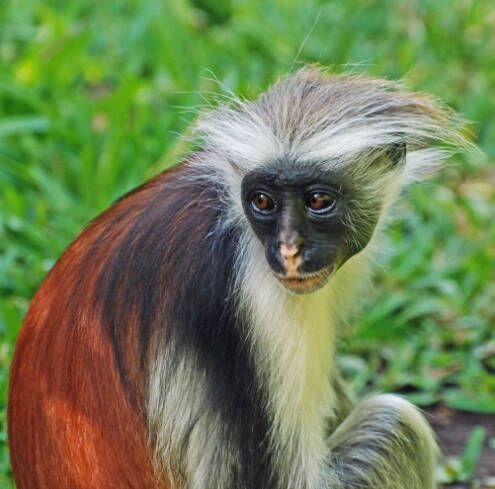Piliocolobus kirkii
IUCN
LCBasic Information
Scientific classification
- name:Piliocolobus kirkii
- Scientific Name:Piliocolobus kirkii,Zanzibar Red Colobus
- Outline:Primates
- Family:Cercopithecidae R.Colobus
Vital signs
- length:45-65cm
- Weight:5.2-11.3kg
- lifetime:No verification information
Feature
White hair forms the crown and the back has an attractive dark red coat
Distribution and Habitat
Distributed on Zanzibar Island in Tanzania, mainly in the Jozani Forest Reserve, with a small number living near Pemba Island and Ngezi Forest Reserve.
It inhabits tropical evergreen forests, primary and secondary forests, agricultural land and recreational gardens. It mainly lives in forest areas with groundwater, as well as in shrub forests with coral reefs in the south and east of the island, and also in mangrove swamps.
Appearance
The Zanzibar Red Colobus has a slender body, a head-body length of 45-65 cm, a tail length of 58-77 cm, and a weight of 5.2-11.3 kg. This species has a crown formed by long white hair on its head, black cheeks, a white base and a unique pink lips and nose. The back has an attractive dark red coat, which is also covered with long black hair. Like other colobus species, the anal wart is small and the tail is long, which plays a role in balancing the body. The cheek pouches are also smaller than those of ordinary monkeys. They are different from leaf monkeys in that they have no thumb, although the other fingers are particularly long, and the thumb has degenerated into a small wart, so they are called colobus monkeys. The surface of the head and the back of the upper body is mainly reddish brown or dark brown, and the fur on the inner surface is white. The outside of the arms and legs is black hair, while the inside is white. The rough tail is white below and red or dark yellow-black abov
Details
Zanzibar Red Colobus (scientific name: Piliocolobus kirkii) is called Zanzibar Red Colobus in foreign language, and has no subspecies.

Zanzibar Red Colobus is a diurnal animal. It is arboreal and moves quickly between genera. The group consists of multiple males and multiple females, with each group of 5-50 monkeys. The group generally consists of an adult male and several adult females and young monkeys. Males leave the family group when they reach adulthood. Living in highly degraded forests, food-scarce groups are believed to adopt a "fission-fusion" social system, in which larger groups split into smaller groups to live. They live in overlapping home ranges.
The complex structure of the Zanzibar red colobus' stomach has been adapted to digest leaves. It is a complete vegetarian, eating large amounts of leaves, fruits, mosses and seeds every day, up to 2-3 kg per day. It occasionally eats soil and charcoal to help digest toxins on the leaves. Young leaves and leaf buds make up more than 50% of the diet. In forest-dwelling groups, unripe fruits make up another 25% of the diet; in groups in agricultural areas, leaves from herbaceous plants are the second largest food source (about 15% of the annual diet). Some groups regularly feed on mangrove leaves.
Males reach sexual maturity at about four and a half years of age, while females reach sexual maturity at about four years of age, after which females are known to have a prominent pink swelling of the genitals during estrus. Gestation period is 5 months, and one litter is born each year. After the birth of the pup, the female is fully cared for, and the mother carries the pup in the trees for the first 3 months.
The distribution range of the Zanzibar Red Colobus is very limited, and the species is limited to the island of Zanzibar, including the Ngezi Forest Reserve near Pemba Island. The number is between 1,000 and 1,200 (2016). The number is believed to be declining, and the reason for the decline is that the local original forests have been almost completely replaced by cultivated crops. Habitat destruction has been caused by changes in the habitat due to burning of plantation forests and shrubs. The species is occasionally used for food, and is killed by humans as a presumed pest for activities and foraging. However, habitat loss remains the most serious threat. In Jozani Chwaka Bay National Park, past habitat degradation, mainly from commercial logging, agricultural reclamation, firewood and charcoal production, has ceased. Occasionally, Zanzibar red colobus monkeys are killed due to road traffic accidents south of the park. For these reasons, the species has been listed as endangered.
Listed in the 2008 IUCN Red List of Threatened Species ver 3.1 - Endangered (EN).
Protect wild animals and stop eating game.
Maintaining ecological balance is everyone's responsibility!








